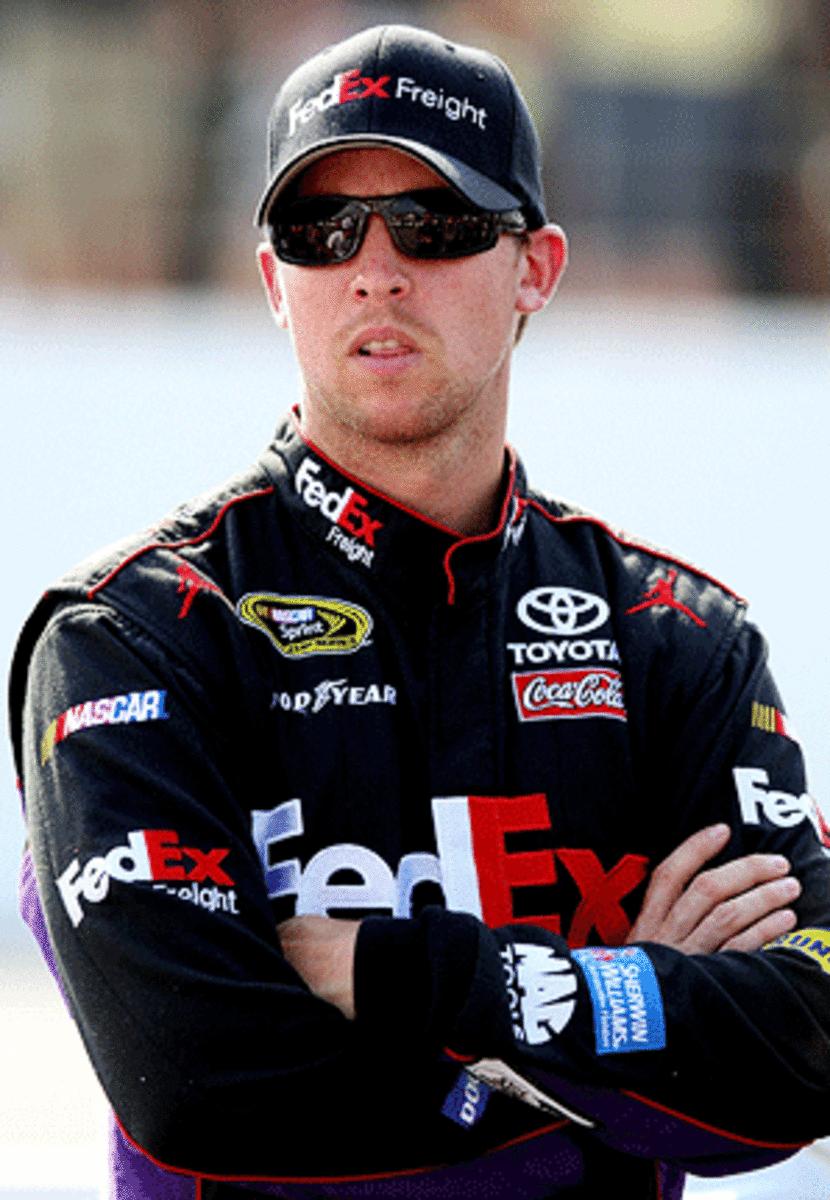Denny Hamlin wages valiant fight at Cup stop in New Hampshire


Few motivators are more powerful than desperation. One can wax poetic about pride and determination pushing an athlete when victory seems furthest, but a desperate competitor is one often too upset to care about the consequences. It is in those moments of controlled anger, not out-of-control rage, where some of sport's more memorable events occur.
NASCAR fans have witnessed such highlights throughout the sport's history. Tony Stewart provided one of the more notable examples last year with his drive to the championship three months after he suggested that his team would be wasting a spot in the Chase the way it was running at the time.
Denny Hamlin provided a similar moment Sunday. A celebration did not ensue. Instead, he was left with lip-biting angst after he finished second to Kasey Kahne.
Hamlin's charge showed why he could be closer to a title than he was in 2010 when Jimmie Johnson beat him. Hamlin raced under control.
His furious run ranks among the top individual performances this season. It's there with Kurt Busch's run for the lead at Sonoma with a damaged car as wild as a bronco. It's there with Kyle Busch's win in the Budweiser Shootout, in which he nearly spun twice before nipping Stewart for the victory. It's there with Brad Keselowski's move to unhitch Kyle Busch and pull away on the last lap to win at Talladega.
Hamlin's moment, though, should have never happened.
He had the best car at New Hampshire, leading 150 of the 301 laps. Except for a few laps during a green-flag pit cycle as the field reshuffled, Hamlin was not out of the top five all day -- until his final pit stop with 67 laps to go.
Crew chief Darian Grubb and Hamlin discussed the car's handling and how much Hamlin had worn his tires. Grubb called for a two-tire stop. Hamlin agreed, saying he wanted tires.
Grubb, thinking Hamlin meant he wanted four tires instead, called for a four-tire pit stop that kept Hamlin in the pits longer than the leaders, who changed only two tires.
"I was shocked when [Hamlin] took four and kind of gifted us the lead there,'' said Kahne's crew chief, Kenny Francis.
Kahne, pitted near Hamlin, saw Hamlin's jackman run from the right side of the car to the left and jack it for a four-tire stop as Kahne left pit road.
"As I left the pits, I looked in my mirror,'' Kahne said. "There were tons of cars coming out on two [tires].''
Hamlin entered the pits first. He left 13th.
"What made us switch to four?'' Hamlin asked Grubb on the radio after the stop.
"You said you wanted four tires,'' Grubb said.
"Oh God. No. I just said put tires on it.
"My bad, bud. You go out there and make it up for me,'' Grubb said.
Hamlin knew unless there was a caution, he wouldn't win.
"As hard as it is to keep your emotions in check, you have to take it in stride and realize, after you pull out on pit road, go out on the racetrack, there's nothing you can do about it,'' Hamlin said afterward. "All you can do from that point forward is figure out how to get the best finish you can that day. If you harp and moan on it, you're just going to go backward. [Sports psychologist] Bob Rotella has the key: Think forward, not think about anything bad that just happened.''
That's one of the key lessons of Hamlin's performance. It's not that he failed to win, it's that he didn't fail to try. How many drivers would have been too upset to perform to the level needed? Hamlin, mindful of what Rotella has told him, refocused and moved forward instead of festering over what happened.
One of the key attributes with Jimmie Johnson and his team is their ability to recover from setbacks during a race and get the best finish possible. That helped Johnson to five consecutive titles, including in 2010, when he came from behind entering the season finale at Homestead to beat Hamlin for the championship.
Stewart won last year's crown after the decision had been made that Grubb would not return to the team after the season. That would have saddled many teams, but Stewart won five of the last 10 races to beat Carl Edwards for the title.
Hamlin showed that Stewart spirit in the car Sunday, nearly climbing back to the lead on a track known for its difficulty to pass. It's easy to be trapped in traffic and disappear. Hamlin's teammate Kyle Busch couldn't break through the pack. Johnson also struggled to do so. Not Hamlin.
"I could see Denny coming,'' Kahne said.
Hamlin gave fans something to watch. Certainly, his run was aided by competitors who did not hinder his progress too much. They knew he had one of the best cars. Even if they held him up a lap or two, it would only delay the inevitable. So, that made it easier but that didn't mean Hamlin was taking it easy as he chased Kahne.
"I was on the edge of every corner entry the last 20 laps probably,'' Hamlin said. "I was doing everything I could. All I wanted to do was just get close enough where I could hit [Kahne] to make it somewhat interesting. I just didn't have enough distance. He just stretched out so far that we ran out of time. Really I ran out of brakes and talent with a couple laps to go.''
What Hamlin didn't get this time might help him score the biggest win of his career later this year. NASCAR's 10-race title chase is pressure-filled, where anxiety and anger can be constant companions when mistakes happen. It's how one overcomes those that will determine who hoists the championship trophy at Homestead. Hamlin showed he has the mettle to do so.
